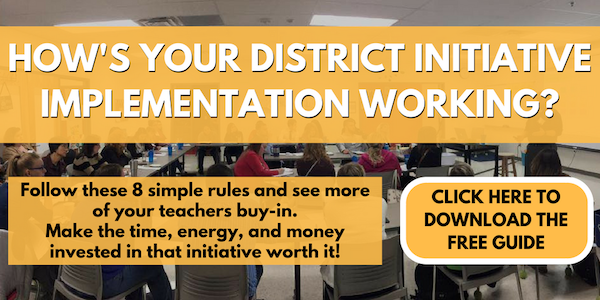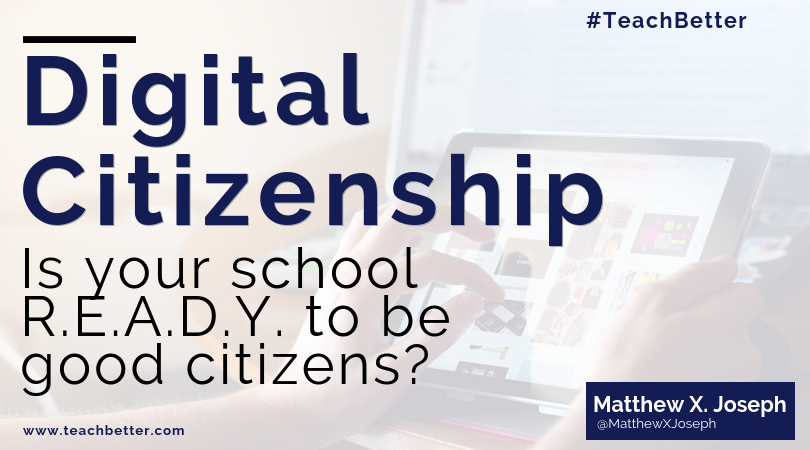Are your students ready to be good digital citizens?
Todays’ students are using technology to collaborate, learn, research, and communicate while at school. Blended and personalized learning with digital tools has flooded classrooms, but most teacher-prep programs do not incorporate digital citizenship as requirements for teacher certification. This leads to a cross roads of districts pushing digital learning into schools with teachers who may not be trained in the use of safe online instruction and hence the problem of a fear of the internet. Before embarking on any sort of mission to teach students, staff many need to familiarise themselves with things like these top cybersecurity facts so they themselves are informed and able to deliver the lessons confidently.
Launching technology lessons or creating online learning is a huge responsibility. Teachers are asking students to be safe online, but we must do more than trust they are safe. Since 91% of colleges grads own a smartphone, we need to make teachers and students aware of the concerns. Then empower both with strategies to be good digital citizens.
Digital Citizenship: Is Your School R.E.A.D.Y. to be Good Digital Citizens? Click To TweetIf we don’t teach our students proper digital citizenship, we run the risk of:
- Students sharing personal information.
- Students using classroom technology for cyberbullying.
- Students searching or sending inappropriate photos or images.
- Not preparing our students for a digital world.
The list could go on, but essentially, anything on the Internet with your name on it is a digital record. Unfortunately, students rarely think twice about putting their names on things online, so their digital presence can be wide.
Some things students may not think about are:
- If you visit a website, the website usually looks at what websites you were on before and after you looked at theirs.
- Anything that you search on Google can be looked up.
- If you want a job in the future, but you have a negative digital presence, there’s a good chance you’re not getting the job.
- Every computer has an internal number, so if you write something negative online, it is recorded.
Every time you hit “tweet” on Twitter, update or add your opinion to Facebook, share a photo on Instagram, Pin a recipe, or even “like” a post, you add to your digital footprint.
You might be asking yourself “what is a digital footprint?” When you walk on a beach and leave a footprint, and the wave rushes over – it is kind of Hollywood to see the footprint go away. However, your digital footprint is not easily washed away, and a more accurate description of digital footprint is a Digital Tattoo because it is not easily removed. One of the only ways to stay anonymous on the internet is by using a proxy. Websites like free-proxy-list.net can provide anonymity for those searching online.
As educational leaders, we must combine the use of online work, encourage online storytelling through blogging or web creation, and encourage students researching and branding great ideas. That encouragement comes with teaching students/staff to be thoughtful around what is posted because there is NO GUARANTEE information/data has been shared online will ever be removed from the Internet.
The goal of this post is not to deter the use of online learning. It is to encourage the use, but also encourage mindfulness of what is posted, because what you put online may never go away.
[scroll down to keep reading]
So, how can we encourage a positive online image?
Today’s classrooms are providing opportunities for students to learn with technology tools and nonstop information. Online learning provides students the ability to communicate and interact very quickly. The growth of 1:1 and digital initiatives in schools is driving the conversation and need to highlight the responsible use of technology in education. When you teach digital citizenship to your students (or children), you help create a positive school culture that supports safe and responsible technology use.
Here are some reflection key questions to help:
What impression are you giving? If you didn’t know you, what would you think about this post? What impression would you have of the person who posted it?
Is the Tattoo ‘ink’ what I want out there? When you share something online, you turn over control of it. Even if you delete a photo or post, you can’t guarantee that it hasn’t been copied or downloaded by someone else. Don’t forget how easy it is for other people to copy what you share online, change it, and share it without you knowing.
Am I oversharing? The more you share, the more people learn about you. You can’t control how someone else uses the information.
Would I want someone to share this fact/idea about me? It’s important to think about the impact what you post online might have on others.
Does it pass the newspaper test? Before you post something online, think: would you be happy to see it on the front page of local newspaper?
Teachers have long understood the importance of teaching and modeling good global citizenship in their classroom, positive interactions between students, and taking the time to focus on social etiquette and how to treat their peers with respect. Digital citizenship requires that same daily instruction and opportunities to practice using their digital citizenship skills.
In today’s classrooms, it is just as important that students understand what kinds of behaviors are acceptable “online.” Teachers can use instructional time to incorporate digital citizenship skills to help students become smart, responsible, and respectful online users.
There are many positive uses of online learning and social media and it is critical to have conversations about the current and desired state of digital citizenship in a school. These critical conversations are essential in K-12 education today with all the access our students have. What school can do tomorrow is start the conversation about good online digital citizenship with teachers and students to begin to cultivate a culture of positive online users.
Here is how your school can be R.E.A.D.Y. to be good digital citizens.
- R: REMIND. Remind students to be mindful about what information and opinions they make public. Use information shared to educate students on the negative aspects and the unknown facts about online use.
- E: ENCOURAGE. Encourage students to step away from their phone and/or computer screens when hanging out with friends; offline peer relations are just as important as online ones!
- A: ACCOUNTABLE. Encourage digital accountability by creating a student digital use guide for online use that teaches students how to properly and safely use the internet. Districts may have a district responsible use policy, but a classroom reminder always helps.
- D: DEMONSTRATE. Incorporate lessons about the difference between sharing and stealing online content. Content and photos are easily found and it may feel like anything on the internet is up for grabs, but copyright and intellectual property laws protect almost all online content. By demonstrating and modeling good digital citizenship, you are embracing and promoting a culture of positive online use.
- Y: YES. Be a culture of “Yes” when launching digital tools. Too often schools block or lock down everything to be safe. Instead of blocking and locking (because we know that blocking is just an invitation for kids to go around it) start teaching positive digital citizenship by opening tools like YouTube and Twitter and teaching and modeling the positive uses of these tools.
Today, nearly everyone seems to have some type of presence online. Schools should explore ways to help students intentionally build a positive digital identity. Student portfolios, blogs, and other online tools provide avenues to assess learning while simultaneously allowing students to develop a positive online presence. Students can use these tools to showcase their learning while also highlighting their strengths and personality. Having a positive identity that represents their authentic self will be valuable when the student applies to college or for a job.
Rather than just teaching children about internet safety and reducing their digital tattoo, we should also encourage them to design and ink a positive digital tattoo, which will be an asset for them in their future.
About Matthew X. Joseph, Ed.D.
Dr. Matthew X. Joseph is the Director of Digital Learning and Innovation in Milford Public Schools (MA). Previously, he served as an elementary school principal for 11 years, which givens Matt incredible insights on how IT can best support teaching and learning, for which is recognized nationally. Matt holds licenses in education, administration, and MA superintendent. His master’s degree is in special education and his Ed.D. in Educational Leadership from Boston College. Matt is an accomplished writer in the EdTech space with articles featured in Tech and Learning Leader (blog), eSchool News, and EdTech K-12 and he regularly presents at MASSCUE, ISTE, and many other regional and national events. At FETC 2019, Matt will present “Blitz Educational Transformation” in the FETC 2019 IT Track and serve on the “From IT to Innovation” panel.
Blog header image photo by Taras Shypka on Unsplash.



